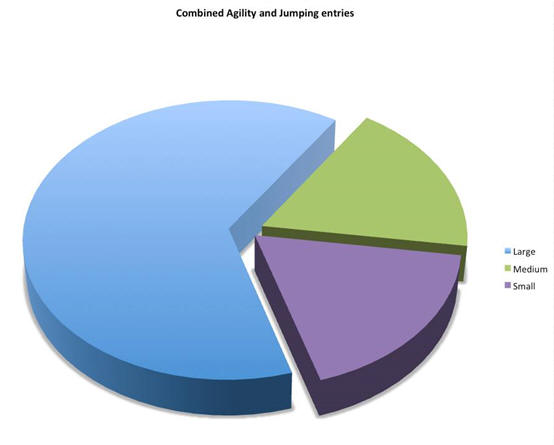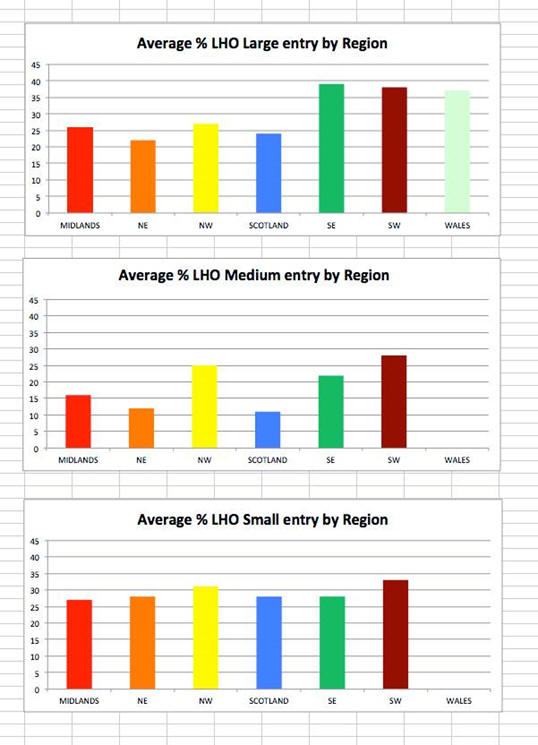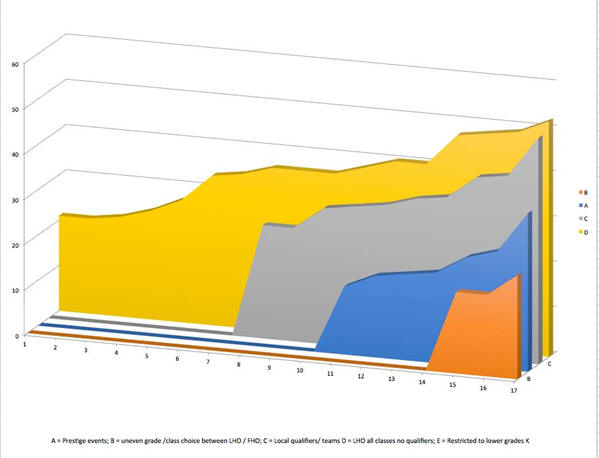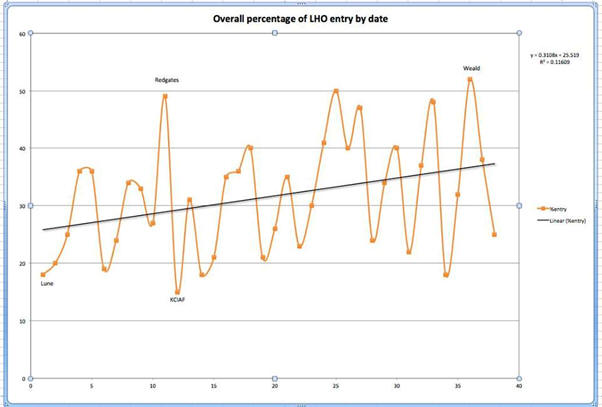Kennel Club 2016 shows...
 Between July 1st and October 30th
2016, there were around 120 Open Kennel Club shows scheduled. A little less than half of them - 56 to be exact - offered classes
with a Lower Height Option (LHO). The following report was compiled from data
gathered by the 4th Height Supporters Group to be used along with other data
gathered from a grading review and jump research findings when decisions about
the future of agility are made. Now with feedback from
Jo Sermon. Between July 1st and October 30th
2016, there were around 120 Open Kennel Club shows scheduled. A little less than half of them - 56 to be exact - offered classes
with a Lower Height Option (LHO). The following report was compiled from data
gathered by the 4th Height Supporters Group to be used along with other data
gathered from a grading review and jump research findings when decisions about
the future of agility are made. Now with feedback from
Jo Sermon.
The 4th Height
Supporters Group believes this data supports the need, desire and viability for
a separate, competitive '4th' height category between Medium and Large, to
include access to 'prestige' events and Championship classes.
This additional
category would create a level playing field for dogs that are currently
disadvantaged by the span of the Large height category. Whether this category is
a 'measured' height for smaller Large dogs, or an optional height for all Large
dogs, it would have at least the second highest entry numbers for any
category. We also believe this separate height band would resolve any possible
conflict that may exist in the current system
between 'the best height for a dog' and the 'best chance of success,' thereby
benefitting more dogs overall.
With the overall popularity for lower height
jumping increasing and research now in place, we hope to see this instigated
soon. To us, it would be the best option.
Background
In June 2008 the first Proposal for an additional hurdle height at
550mm for smaller Large dogs was presented to the Kennel Club's Agility Liaison
Council for their consideration. Co-incidentally a Discussion Item for
'preferred height' classes - for example, Large dogs could jump Medium hurdles -
was included on the same agenda. Neither was taken forward at that time for
reasons given in the corresponding ALC minutes.
As time passed, the 4th
Height Supporters Group was formed on Facebook, and the interest and concern
over the difference in hurdle heights between the Medium and Large categories in
particular - and hurdle heights in general - has grown immensely. This is a
trend that is being mirrored throughout the Agility world, with many countries
adopting different hurdle and dog height categories in their domestic
competitions to those used at the two FCI Championships.
Following on from
another Discussion Item in January 2013, which led to the instigation of some
research into dogs jumping by the KC, a further Proposal for a 550mm hurdle
height band was tabled for consideration by the Agility community on the ALC
January 2015 agenda. See details on the
website. The ALC decided
that, although there was very strong support at all the regional meetings for
this change, they wanted to be certain that there were no welfare issues that
would stop this being accepted and decided to defer their decision until more
research results were available.
In October 2015,
Wrexham DAC wrote to the ALC and an
open letter was sent to the KC Chairman, both asking for a decision on the
Proposal for a 550mm hurdle height to be moved forward.
At the January 2016
ALC meeting, the Representatives were informed that the KC had decided to
introduce the interim measure of the Lower Height Option from July 2016 (see KC
website for details) 'while research is concluded and findings made available to
inform the debate'. Such results are now available from studies conducted by
Nottingham Trent University and the Royal Veterinary College, all of which
underpin the Proposal for smaller dogs to jump a lower height hurdle. (See June
2016
Newsletter.) In fact, some of the same data has already been used to
support the recent Proposal for the change in the regulation concerning spacing
between obstacles that was approved by the KC's General Committee in the
quickest possible timescale, for health and welfare reasons.
Methodology
Members of the 4th Height Supporters Group on Facebook were asked to
supply ring plans whenever they attended a KC Open, Premiere or Championship show. Data has been captured from
38 shows, representing almost 70% of shows offering LHO during the period of
1st July to 30th October 2016. Every
submitted ring plan that was useable was included.
-
Data was captured
at the lowest level possible from the numbers available on ring plans,
allowing it to be used in detailed analysis or in aggregated form.
-
Data was gathered
and stored by Show/Day; Height; Grade; Graded or Combined; Entry Numbers
Jumping; Entry Numbers Agility.
-
The numbers were
then analysed to determine the Overall percentage LHO entry at each
Grade/Grade Combination and the Overall percentage LHO entries by class type
for each Show/Day.
-
Further
information was added in to allow aggregation of data by Region and by
presence/absence of Qualifiers.
-
KC limited shows
were not included.
The shows
analysed, in chronological order, were:- Lune, Wellingborough, RVA, Newlands, Billingshurst, The Agility Club, Empingham, Wirral, Rushden, BCC GB,
Redgates,
KCI Agility Festival, Adams, TAG, Westgate, Orchard, Bridgehouse, Surrey, Gleniffer, Gillingham, Prestbury Park, Blenheim, Blackdown, Tenterden, Breerock, Stonebridge, Waverunners, Train In The Ring, Suffolk Five Rivers, Southdowns, South Durham, Chippenham, Mid Downs, Shrewsbury,
Weardale, Weald, BHC and Excel.
Direct comparisons
are sometimes difficult at detailed level across all the shows because
information is not always constant or is sometimes not known. For example, where
Grades are combined in a class, it was not normally possible to determine entry
numbers by Grade.
It was not possible
to report the effect of combining or splitting results, as this data was not
available on ring plans.
Summary
Almost half of KC shows offered LHO in some format between July and
October. We are not aware of any shows offering LHO in Northern Ireland.
Handlers are making
decisions to enter/not enter LHO using several criteria. In particular, support
for LHO at Medium is noticeably less than at Large and Small heights and is not
driven by Grade. It, therefore, seems likely that Medium dog handlers are
mostly satisfied with the full height hurdle to dog height ratio.
Variability in uptake
across shows and regions is much less at Small height than at Large. Overall
numbers are considerably lower, and the range of grade combinations for classes
is greater. Small dog handlers are more used to restricted choices than Large
dog handlers.
LHO is most strongly
supported in the Large height category. Across the timeframe and the shows
analysed, there are close to twice as many Large dogs competing than Small and
Medium dogs added together.
The effect of 'qualifiers' on people's choice of
class entry is apparent in most shows hosting prestige classes such as Crufts
and Olympia qualifiers, particularly the Kennel Club International Agility
Festival (KCIAF) where the Cup competitions dominate the schedule. However, the
effect doesn't carry through for other types of Special classes such as Teams or
more local Cup/qualifiers.
There is also no evidence that the LOW 550 Special
class on its own significantly increased Large LHO entries at the shows
involved. An effect is seen, however, where there is choice within a schedule -
regardless of whether the choice is a qualifier or uneven grade combinations
across the LHO/non-LHO class choices or number of available runs at a show.
Main facts Ė Overall Numbers
-
The uptake of the Lower Height Option for
Medium dogs is consistently less than for Small dogs.
-
There are almost twice as many Large dog
entries overall than there are Medium and Small combined.
-
There are six times as many Large dog
entries at LHO than there are at Medium.
-
There are four times as many Large dog
entries at LHO than there are at Small.
-
There are marginally more dogs entered at
Medium than at Small (approx 5%), but a higher proportion of Small dogs are
entered at LHO (19% Medium / 26% Small).

Detail
-
A total of 61,221 entries were recorded
in Agility classes across all heights and grades.
-
64% of these were at Large height, 17.6%
at Medium and 18.4% at Small height.
-
A total of 59,987 entries were recorded
in Jumping classes across all heights and grades.
-
64% of these were at Large height, 18% at
Medium and 18% at Small height.

-
30% of the total Large Agility entries
and 31% of the total Large Jumping entries were at LHO.
-
17.9% of the total Medium Agility entries
and 18.6% of the total Medium Jumping entries were at LHO.
-
26% of the total Small Agility entries
and 25% of the total Small Jumping entries were at LHO.

Main facts - Differences involving Heights and Grades
-
Just under a quarter of the shows
analysed offered LHO for Large height classes only.
-
There is no clear pattern of effect of
grades on % LHO entries at Medium height. At several shows, the highest
levels of % LHO entry were achieved by dogs in the higher grades.
-
In most cases, the higher % LHO entry
numbers are found in the lower grades at Small height, although individual
classes and shows occasionally recorded higher grades with high % entries at
LHO.
-
The higher % LHO entry numbers are
dominated by the lower grades at Large height. There is a clear correlation
between % LHO entry numbers and grade of dog at Large height.
-
Variability within the data was most
marked at Large height. Where all classes offer LHO, there is no indication
at any of the heights or grades that the choice between Graded or Combined
classes has an effect on % LHO entries. However, when there is a choice
between classes with LHO and classes without LHO, (providing the possible
number of runs for a dog is the same), classes spanning the least number of
grades are chosen more often.
Detail
-
Wirral recorded the four highest Medium
percentage of LHO entries overall. These ranged from 60% in a CG 6/7
Agility class through 52% and 47% in two Graded 6/7 Agility classes to 44%
in a CG 5-7 Jumping class. Wirralís
-
Wirral also recorded the three highest
Small class entries overall. These ranged from 100% in a Graded 6/7 Agility
class through 68% in a CG 1/2 Agility class to 56% in a CG 1-3 Agility
class. Wirralís lowest Small entry was 19% in a CG 4/5 Jumping class and
19% in a Graded 4/5 Agility class.
-
The single highest % entry for any LHO
Large class was 72%, at Weald show on Sunday 9th October. This 2
ring show in East Sussex had an overall entry of 146 dogs in Large Graded
1-3 Agility. 106 of these dogs entered at Lower Height. The results were
combined. Similar numbers were given for entries in Large Graded 1- 3
Jumping and Large CG 1-3 Jumping.
-
The highest % Large class entry at Grade
6 or 7 is 52%, recorded at Orchard show, after which there are very few
examples of classes for Grade 6 or 7 with % entries greater than 35%.
-
From a total of 532 scheduled Large
Jumping and Agility classes, the bottom 23% was dominated by classes for
Grade 4 and above. Only 4 classes in the bottom tier were for Grade 1,2 or
3 dogs exclusively. Two of these four classes were at KCIA *.
Main Facts - Performance by Kennel Club Region
-
Uptake of Large and Medium LHO varies by
Region but is similar across all Regions at Small LHO.
-
The Midlands, North East and Scotland are
the bottom three at all heights.
-
The North West attracts more LHO entries
at Small height than the other two heights.
-
The South/South West attracts most
entries overall.
Detail 
Main Facts Ė The effect of Qualifiers/Choice
-
A review of the % LHO entry numbers split
between shows with standard classes only and those with some kind of
qualifier/ special event produces two sets of numbers whose range and
average is very similar.
-
A closer look at the data shows that
overall LHO entry levels are influenced not only by availability of prestige
qualifiers, but also where there is an uneven choice between the grade
combinations available with/without LHO.
-
This response to scheduling indicates
that there is a proportion of handlers who are sufficiently competitive to
view the options by class with likelihood of success in mind. This effect is
most marked in the Large height dogs.
-
For example, a choice between an equal
number of possible classes with/without LHO but where classes without LHO
are split into Grades 1-3, 4-5, 6-7 and with LHO are split into Grades 1-4
and 5-7.
-
Entry levels
at LHO for Large dogs showed the most variability. The lower end of this
range is driven by the prestige qualifiers and uneven choices effect.

When shows are
grouped according to potential influences on handlers' entry choices, distinct
effects are seen. The profiles of the four blocks on the chart indicate that
entries are generally lower in shows offering prestige classes such as Crufts
and Olympia qualifiers (blue on chart). Equally affected are shows that offer
better options for grade combinations or numbers of runs at FHO than LHO (orange
on chart). More local qualifiers/teams etc had a much less marked effect on
entries (grey on chart). The yellow block indicates the overall profile for
shows where every class in a height category offered LHO. There was only one
show in category E = Restricted to lower grades, which has little bearing
overall and is not shown on the chart.
Main Facts - Is popularity growing?
Using the gathered
data, we plotted the average percentage of LHO entries across all heights and
grades by show from July to mid-October.
Because of the
multiple possible permutations of grade combination, overall entry numbers and
class choices linked to other classes without LHO (qualifiers, teams, etc), this
information is varied. A linear calculation through the individual plots shows
an upward trend.

In
Conclusion
This report is an
analysis of Kennel Club shows over a four month period from the date of the
introduction of LHO in order to provide an overview of what was happening at
shows where LHO was offered. It is a collation of information from ring plans
made available by many people.
We had no
preconceptions about what the data might reveal, and really there are no great
surprises in the data.
There were, however,
clear differences in actual entry numbers between Large and Small/Medium.
-
Uptake is lowest
in the Medium height range.
-
There are far
more lower grade Large dogs entering LHO than the higher grades.
-
Overall there was
an upward trend of entry numbers from July to October.
-
There is a lower
takeup at shows which host prestige qualifiers, indicating that success in
the ring is a key reason when deciding which classes to enter.
From a 4th height
perspective, we believe that this supports our quest for a fully competitive and
integrated height aimed at the 'smaller Large' dogs.
We hope this report
will be used in the spirit in which it is offered - as another piece of the
research to help when when decisions about the future of agility are made.
If you have any queries,
you can contact the 4th Height Supporters
Group on Facebook or by
email.
First published
21 January 2017
 Feedback
from Jo Sermon... Feedback
from Jo Sermon...
I have been competing in agility
in the UK since the late 80ís. Iíve been privileged to teach agility all over
the world, from Australia to Japan, all across north America and Europe. During
my travels, Iíve seen agility in many different forms and dogs competing at many
different heights and under many different rules. Agility in the UK is radically
different, just the sheer size of our competitions has no equal anywhere in the
world. Iíd like to reply to this article because it makes several
misleading assumptions and I believe the conclusions that it draws are
misguided.
Between July 1st and October 30th
2016, there were around 120 Open Kennel Club shows scheduled. A little less
than half of them - 56 to be exact - offered classes with a Lower Height
Option (LHO). The following report was compiled from data gathered by the
4th Height Supporters Group.
So far so good.
'to
be used along with other data gathered from a grading review and jump
research findings when decisions about the future of agility are made.'
I hope that when decisions
are made about the future of agility that a full study is used to base those
decisions on. This data is collated and presented to support a point of view and
is necessarily biased in that respect.
'The
4th Height Supporters Group believes this data supports the need, desire and
viability for a separate, competitive '4th' height category between Medium and
Large, to include access to 'prestige' events and Championship classes.'
This I
donít understand and, despite patient questions, I am still none the wiser. Why
would the success of the KC's LHO initiative be a reason for a 4th height to be
introduced?
-
What
would happen to all the dogs who currently enjoy the LHO, but which wouldn't
measure into the proposed 4th height?
-
What
would happen to Small and Medium LHO?
-
What
would happen to dogs that would measure into the proposed height but whose
owners don't want them to jump lower?
Personally, I still feel that if someone is advocating a change in our sport,
they should consider the effect of that change on agility as a whole. It is, in
my view, completely unacceptable to propose a change and effectively shrug your
shoulders when the effects of your proposal on others are pointed out.
'This
additional category would create a level playing field for dogs that are
currently disadvantaged by the span of the Large height category.'
This again
makes no sense to me. We have the LHO which dogs are disadvantaged?
'Whether
this category is a 'measured' height for smaller Large dogs or an optional
height for all Large dogs, it would have at least the second highest entry
numbers for any category. We also believe this separate height band would
resolve any possible conflict that may exist in the current system between 'the
best height for a dog' and the 'best chance of success,' thereby benefitting
more dogs overall.'
Large LHO
covers this. Iím still none the wiser as to why we would want a measured height.
To me, the LHO is the far better option, giving Show Secretaries the flexibility
to meet demand in their particular area and allowing larger heavier dogs to
compete at a lower height.
As far as
the data collection is concerned, drawing sweeping conclusions like those above
from data collected in the first four months of a new scheme is somewhat
premature.
We're told
that almost half of the shows during the period offered LHO which means that
more than half did not. Everyone who entered those shows made a conscious
decision to run their dog at full height, yet none of those entries have been
used to calculate the actual take up of LHO. Ignoring more than 50% of the
actual entries raises questions about the accuracy of the conclusions drawn.
Next, no
data was collected about awards, although that data was available. There are
many people who will not enter a show that combines awards across jump heights,
maintaining that a win or place should be against dogs competing on the same
course. To discard that data, as has been done, makes drawing conclusions
ineffective as a major influence has been discarded.
Finally we have no way of
knowing what proportion of the dogs that are shown as being entered in Large LHO
would fit into the proposed measured 4th height.
In conclusion, I see nothing
here that supports the initial premise. I'd like to take this opportunity to applaud
the Kennel Club for their initiative in introducing the Lower height Option. It
is a perfectly tailored solution for those who want to jump their dogs lower,
for whatever reason, whilst allowing our hard pressed show secretaries to tailor
the classes they offer to suit their customers. It supports not only owners of
Large dogs wanting to jump lower, but also Small and Medium dogs
who also want to jump lower.
Many thanks to the hard
working team who came up with it! (2 March 2017)
|